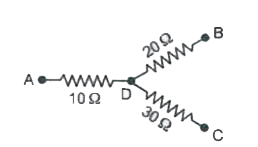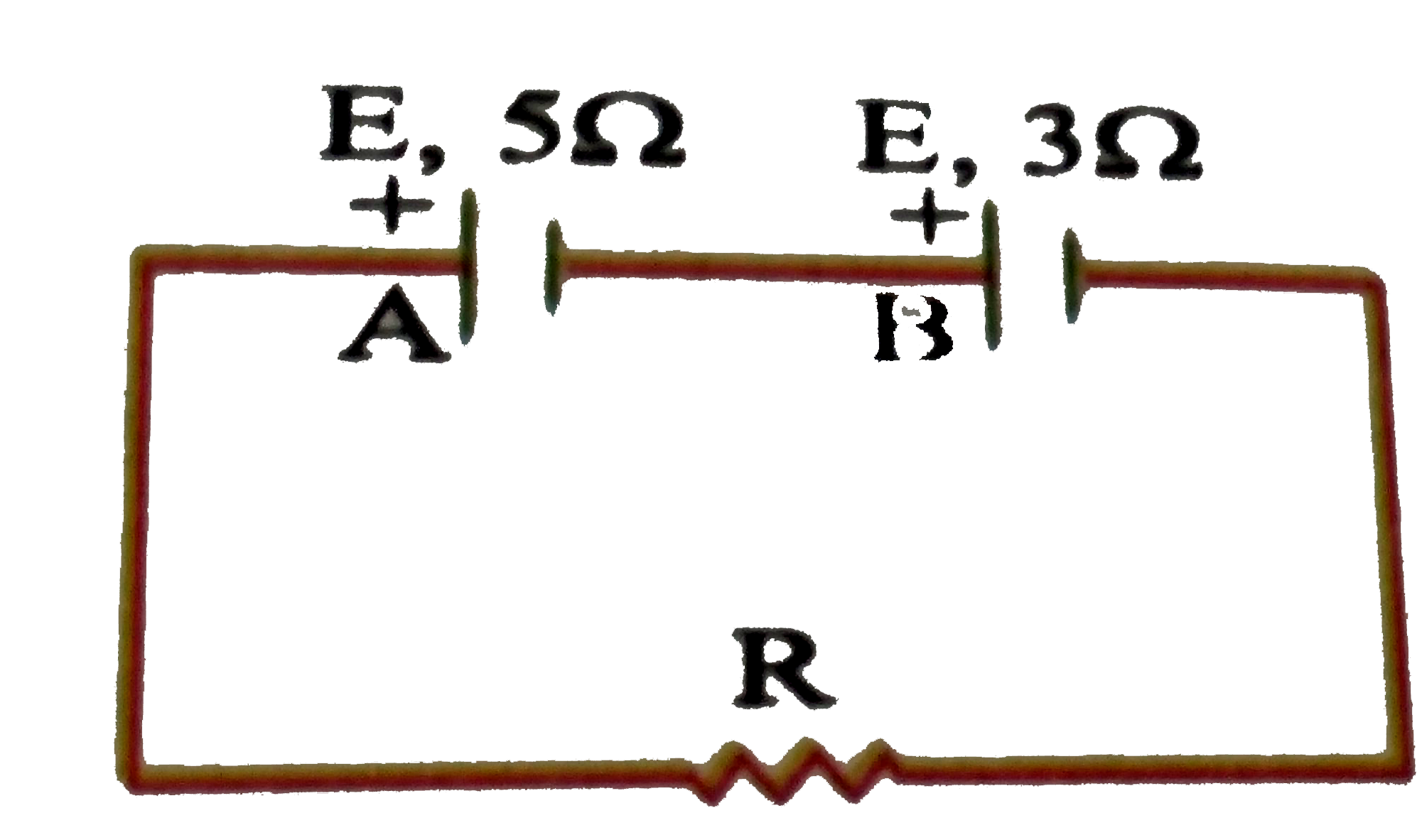In the circuit given here, the points A, B and C are 70 V, zero, 10 V respectively. Then

the point D will be at a potential of 60 V
the point D will be at a potential of 20 V
currents in the paths AD, DB and DC are in the ratio of 1 : 2 : 3
currents in the paths AB, DB and DC are in the ratio of 3 : 2: 1.
The correct Answer is:D
Applying Kirchhoff.s law at point D, we get
I1=I2+I3
VA−VD10=VD−020+VD−VC30
or 70−VD=VD2+VD−103
⇒VD=40V
⇒i1=70−4010=3A

i2=40−020=2A
and i3=40−1030=1A
Topper's Solved these Questions
- CURRENT ELECTRICITYBOOK - MODERN PUBLICATIONCHAPTER - CURRENT ELECTRICITYEXERCISE - MULTIPLE CHOICE QUESTIONS (LEVEL-III)
13 Videos
- ATOMS, MOLECULES AND NUCLEIBOOK - MODERN PUBLICATIONCHAPTER - ATOMS, MOLECULES AND NUCLEIEXERCISE - Recent Competitive Questions
40 Videos
- DESCRIPTION OF MOTION IN ONE DIMENSION BOOK - MODERN PUBLICATIONCHAPTER - DESCRIPTION OF MOTION IN ONE DIMENSION EXERCISE - Revision Test
45 Videos
Similar Questions
Knowledge Check
For the network shown in figure, points A, B and C are at potentials of 70 V, zero and 10 V respectively
 Apoint D is at a potential of 40 VBthe currents in the sections AD, DB and DC are in the ratio 4:3:2Cthe current in the sections AD, DB and DC are in the ratio 1:2:3Dthe network draws a total power of 100 W
Apoint D is at a potential of 40 VBthe currents in the sections AD, DB and DC are in the ratio 4:3:2Cthe current in the sections AD, DB and DC are in the ratio 1:2:3Dthe network draws a total power of 100 WIn the network shown in fig. , points A, B, and C are at potentials of 70 V, 0, and 10V, respectively.
 APoint D is at a potential of 40 V.BThe currents in the sections AD, DB, DC are in the ratio 3 : 2 : 1CThe currents in the section AD, DB, DC are in the ratio 1 : 2 : 3.DThe network draws a total power of 200 W.
APoint D is at a potential of 40 V.BThe currents in the sections AD, DB, DC are in the ratio 3 : 2 : 1CThe currents in the section AD, DB, DC are in the ratio 1 : 2 : 3.DThe network draws a total power of 200 W.In the circuit element given here, if the potential at point B=VB=0, then the potentials of A and D are given as
 AVA=−1.5V,VD=+2VBVA=+1.5V,VD=+2VCVA=+1.5V,VD=+0.5VDVA=+1.5V,VD=−0.5V
AVA=−1.5V,VD=+2VBVA=+1.5V,VD=+2VCVA=+1.5V,VD=+0.5VDVA=+1.5V,VD=−0.5V
Shown a part of an electric circuit, The potentials at the points a,b,and c are 30V,12V,and 2V respectively.Find the currents through the three resistors.

View SolutionIn the circuit element given here, if the potential at point B=VB=0, then the potentials of A and D are given as

View SolutionA circuit has a section ABC if the potential at point A,BandC are V1,V2andV3 respectively , calculate the potential at point O

View SolutionA circuit has a section ABC if the potential at point A,BandC are V1,V2andV3 respectively , calculate the potential at point O

View Solution
In the circuit shown here, cells A and B have emf 10 V each and the internal resistance is 5Ω for A and 3Ω for B. For what value of R will the potential difference across thhe cell A will be zero?
View Solution
